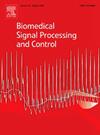A computationally efficient algorithm for estimating respiratory rate from seismocardiogram
IF 4.9
2区 医学
Q1 ENGINEERING, BIOMEDICAL
引用次数: 0
Abstract
Respiratory rate (RR) monitoring is crucial in clinical and healthcare settings. With advancements in microelectromechanical system (MEMS) technology, monitoring respiration using seismocardiogram (SCG) has emerged as a promising approach. This study presents a computationally efficient algorithm for estimating RR from SCG signal. The proposed algorithm consists of two primary steps: first, applying Gaussian averaging filter for pre-processing, followed by computing the averaged spectrum from the scalogram based on complex Morlet wavelet within the specified frequency range. RR is then estimated from the dominant frequency that appears in the averaged spectrum. This study also establishes the analytical relationship between the parameters of Gaussian averaging filter and the sampling frequency of SCG signal, which serves as the design criterion for pre-processing filter. The proposed algorithm undergoes testing on two SCG datasets and demonstrates its feasibility for estimating RR from SCG signal. The algorithm is also tested on both finger and wrist PPG datasets for RR estimation. The test results present high agreement between the RR estimations from SCG (or PPG) signal and those from respiration signal. Furthermore, an experiment using the dataset collected with a magnetic field-based respiration sensor during pulmonary rehabilitation is conducted to validate the algorithm’s robustness against motion artifacts. Based on the testing results, the proposed algorithm shows significant potential in clinical and healthcare applications.
一种计算效率高的心震图呼吸速率估计算法
呼吸频率(RR)监测在临床和医疗保健环境中至关重要。随着微机电系统(MEMS)技术的进步,利用地震心动图(SCG)监测呼吸已成为一种很有前途的方法。本文提出了一种计算效率高的SCG信号信噪比估计算法。该算法包括两个主要步骤:首先,应用高斯平均滤波器进行预处理,然后基于复Morlet小波从尺度图中计算指定频率范围内的平均频谱。然后从平均频谱中出现的主导频率估计RR。本文还建立了高斯平均滤波器参数与SCG信号采样频率之间的解析关系,作为预处理滤波器的设计准则。该算法在两个SCG数据集上进行了测试,验证了该算法从SCG信号中估计RR的可行性。该算法还在手指和手腕PPG数据集上进行了RR估计测试。实验结果表明,SCG(或PPG)信号的RR估计与呼吸信号的RR估计高度一致。此外,利用基于磁场的呼吸传感器在肺部康复过程中收集的数据集进行实验,以验证该算法对运动伪像的鲁棒性。基于测试结果,该算法在临床和医疗保健领域显示出巨大的应用潜力。
本文章由计算机程序翻译,如有差异,请以英文原文为准。
求助全文
约1分钟内获得全文
求助全文
来源期刊

Biomedical Signal Processing and Control
工程技术-工程:生物医学
CiteScore
9.80
自引率
13.70%
发文量
822
审稿时长
4 months
期刊介绍:
Biomedical Signal Processing and Control aims to provide a cross-disciplinary international forum for the interchange of information on research in the measurement and analysis of signals and images in clinical medicine and the biological sciences. Emphasis is placed on contributions dealing with the practical, applications-led research on the use of methods and devices in clinical diagnosis, patient monitoring and management.
Biomedical Signal Processing and Control reflects the main areas in which these methods are being used and developed at the interface of both engineering and clinical science. The scope of the journal is defined to include relevant review papers, technical notes, short communications and letters. Tutorial papers and special issues will also be published.
 求助内容:
求助内容: 应助结果提醒方式:
应助结果提醒方式:


